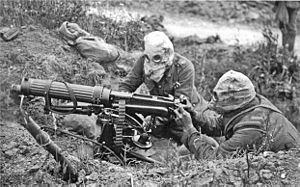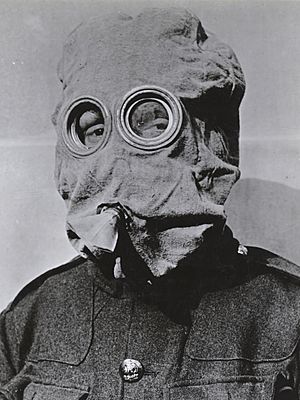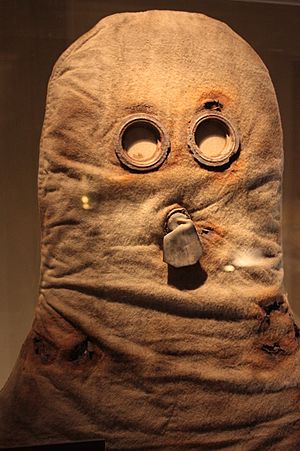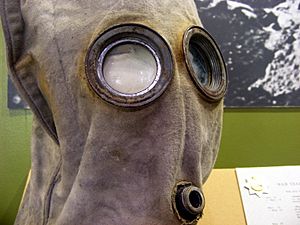PH helmet facts for kids

During World War I, soldiers faced a new and terrible weapon: poison gas. To protect troops, the British Army developed several early types of gas masks, including the P helmet, PH helmet, and PHG helmet. These helmets were designed to keep soldiers safe from dangerous gases like chlorine, phosgene, and tear gas. Instead of having a separate filter, these helmets were hoods worn over the head. They were treated with special chemicals that would stop the gas from reaching the wearer.
Contents
Early Gas Masks in World War I
Poison gas was a frightening part of World War I. It was important to quickly create ways to protect soldiers. These early helmets were a big step in keeping troops safe on the battlefield. They showed how quickly new inventions were needed during the war.
The P Helmet: First Steps in Protection
The P Helmet, also known as the Tube Helmet, was introduced in July 1915. It was an improvement over an even simpler mask called the Hypo Helmet. The P Helmet had two small windows made of mica, which is a clear mineral, so soldiers could see better. It also had a metal tube that the soldier held in their mouth. This tube helped air leave the helmet through a special valve.
The helmet was made from layers of flannel cloth. These layers were soaked in a mix of chemicals called sodium phenolate and glycerin. This treatment helped protect against chlorine and phosgene gas. However, it did not protect against tear gas. About 9 million P Helmets were made during the war.
The PH Helmet: Better Gas Defense
The PH Helmet (Phenate Hexamine) came out in October 1915. It was an improved version of the P Helmet. This new helmet added another chemical called hexamethylene tetramine. This addition made the PH Helmet much better at protecting against phosgene gas. It also offered some protection against hydrocyanic acid, another dangerous gas.
Around 14 million PH Helmets were produced. They were used throughout the war, though later they became a backup mask when even better gas masks were invented.
The PHG Helmet: Adding Tear Gas Protection
The PHG Helmet appeared in January 1916. It was very similar to the PH Helmet. The main difference was that the PHG Helmet had a facepiece made of rubber sponge. This special sponge helped to protect soldiers from tear gas. Tear gas could cause temporary blindness and irritation, making it hard for soldiers to fight.
About 1.5 million PHG Helmets were made between 1916 and 1917. These helmets were an important step in making sure soldiers had protection against different types of gas attacks.
Moving Towards Modern Gas Masks
Even with these improvements, the P, PH, and PHG helmets had their limits. They were eventually replaced by a much more effective design called the Small box respirator in 1916. This new respirator offered much better protection against high amounts of phosgene gas and tear gas. It was a big step towards the gas masks we know today.




